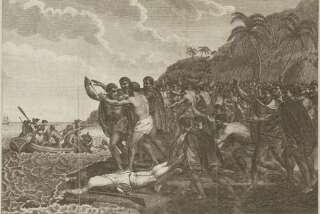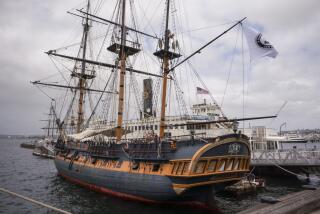Capt. Cook: Vast Achievement of a Steadfast Seafarer : VOYAGES OF DISCOVERY<i> by Lynne Withey (William Morrow: $19.95; 668 pp.) </i>
The three magisterial Pacific voyages of Capt. James Cook between 1768 and 1780 revealed more of the world than any other exploration before or since. Cook may have lacked the fire and fury of Sir Frances Drake, the romance of Louis Antoine de Bougainville and the spectacular daring of Abel Tasman, but he combined the qualities of seamanship, steadiness, authority, perseverance and burning curiosity that made his achievements of discovery the greatest in maritime history.
Cook’s was a life of survival against unusual odds. He was born in 1728 in the humblest of circumstances, and by the time he had matured, only two of seven brothers and sisters had survived. Then there were the years in the North Sea coal trade and later, in the Royal Navy, the four years charting the Newfoundland coast.
It was this North American work that marked out James Cook as a master navigator and surveyor and led to his “plunge into 18th-Century science” on Admiralty orders. And what a plunge it was! The whole Western world had recently been set alight with competitive scientific curiosity. For instance, one of the keys to the door of astronomical research was the precise observation of the transit of the planet Venus as its black shadow passed across the sun in 1769 (not due again until 2004).
One observation, it was decided, must be made from somewhere in the Southern Pacific, an ocean that on charts was little more than a gray expanse, with a few hesitant squiggles to indicate its likely land mass borders: no Tahiti, no Hawaii, only a few doubtful dots, the Spanish Philippines and the mythical Terra Australis Nondum Cognita, which Cook was to prove did not exist anyway.
By the time of the affray on the beach of Kealakekua Bay, Hawaii, which ended in Cook’s death, the Pacific’s 70 million square miles had assumed the general configuration that appears in every school atlas today. From the coast of eastern Australia, all of New Zealand, to Oregon and Washington, Vancouver and Alaska, north through the Bering Straits--all had been charted with breathtaking precision.
But that was not all. Cook took with him some of the greatest specialists of that richly endowed era: the young Joseph Banks and his team on the first voyage, artists like Sydney Parkinson, Herman Sporing, William Hodges, the horticulturist David Nelson, the young surveyor William Bligh. At every stop these engaging pioneer enthusiasts would leap ashore with their nets and notebooks, their drawing materials and scientific instruments, extending the knowledge of fauna, flora and native life in all its aspects. The great majority of their work has never been superseded, and the paintings and drawings are available today through the volumes published by Yale University Press.
Who can blame Lynne Withey for taking on the task of biographer of this remarkable sailor-scientist-navigator? Has she justified the years she has put into her work? Yes. On the whole, yes.
The author is especially good on what Alan Moorehead called “the fatal impact” of Western man on the Polynesians, whose highly developed society was so alien to those who imposed their presence upon them, appearing as they did out of nowhere in what appeared to be great birds of prey. For the Europeans, the islanders’ morality relating to possessions was as conflicting as that relating to sexual behavior, which was lacking in all inhibition.
But the impact was not always fatal. It often led to a rich exchange of ideas, as the author shrewdly notes:
“Like the Englishmen, the Tahitians were fascinated with this strange new culture they had encountered. They constantly imitated English actions; Cook and Banks were particularly amused at Tepau i Ahurai’s attempts to mimic English eating habits. Presumably he was equally amused at the contortions the English went through with knives and forks. Nor could the Tahitians understand why the English insisted on inviting women to eat with them, for they observed rigid segregation of the sexes at mealtime.”
As befits her subject, Withey’s prose is spare and unemotional as she recounts in detail and with little comment the three voyages from departure to return. James Cook, his loyal lieutenants, his mixed crew, his talented passengers make a wonderful dramatis personae for her three-act drama, without any elaboration or over-coloring. Moreover, she sets her long narrative into its historical context deftly. She is especially good on the sociology of the Polynesians, and on the unseemly rush by officers on their return to get their books published first and most advantageously--just like today.
It is a pity, therefore, that the text is marred by a number of errors and repetitions that really ought to be corrected in future editions. The reader is told, on various occasions, that Cook’s father was a farmer, a farm manager and a farm laborer--very different classes of occupation. The parish registers record Cook’s birth as “James, ye son of a day labourer.”
Bligh is introduced, as if for the first time, on three occasions. Conditions in the Royal Navy in Cook’s time were not as “horrible” as the author states. They were certainly no worse than for day laborers, and at least the pay was regular. Nor is it true that most recruits were pressed, as a reading of the 1758 Navy Bill makes clear. Many more were volunteers, like Cook.
At the end of this book you can say, “The voyage has been very agreeable and pleasant,” as Cook wrote to his old employer at the end of his first expedition.
More to Read
Sign up for The Wild
We’ll help you find the best places to hike, bike and run, as well as the perfect silent spots for meditation and yoga.
You may occasionally receive promotional content from the Los Angeles Times.






